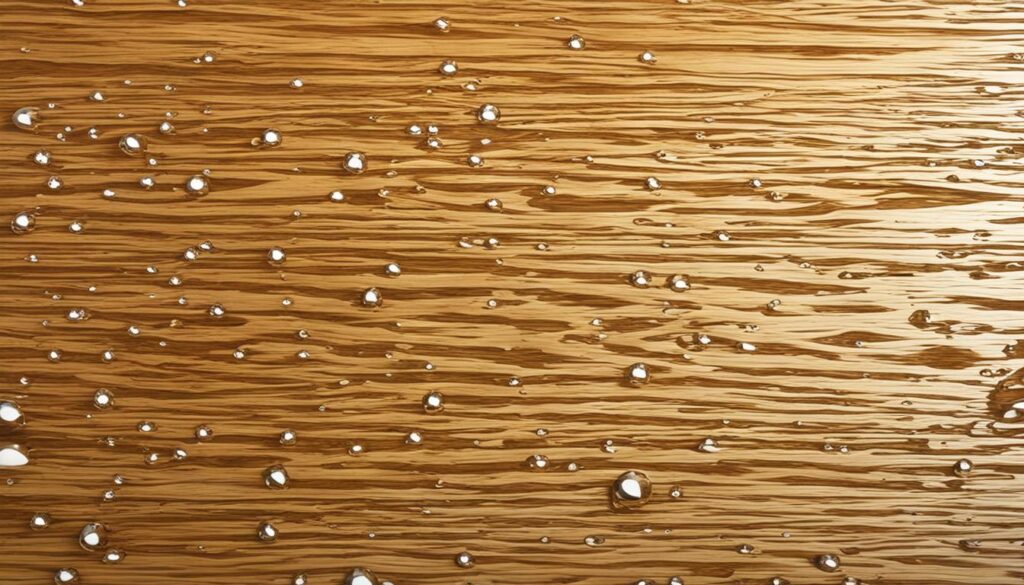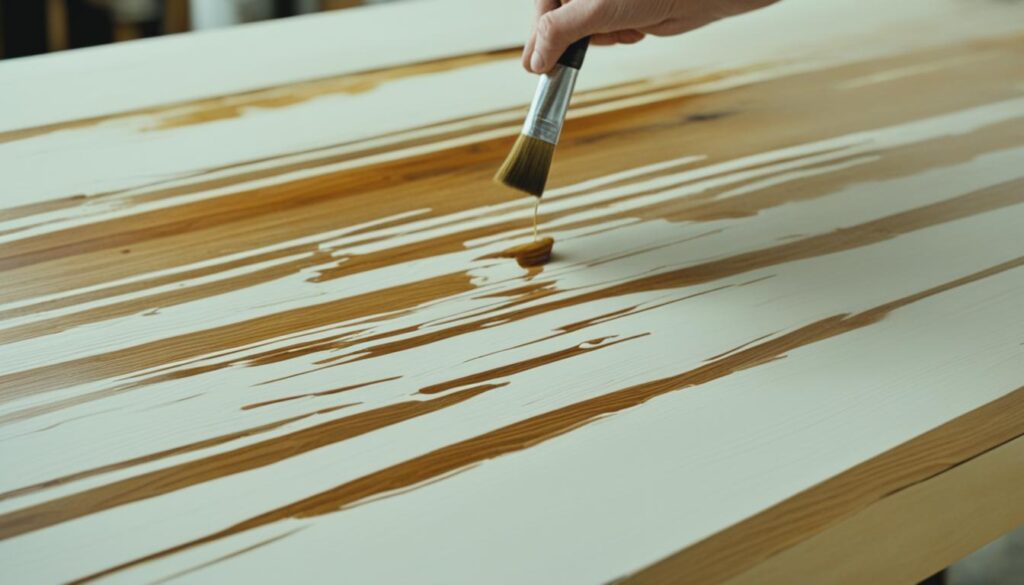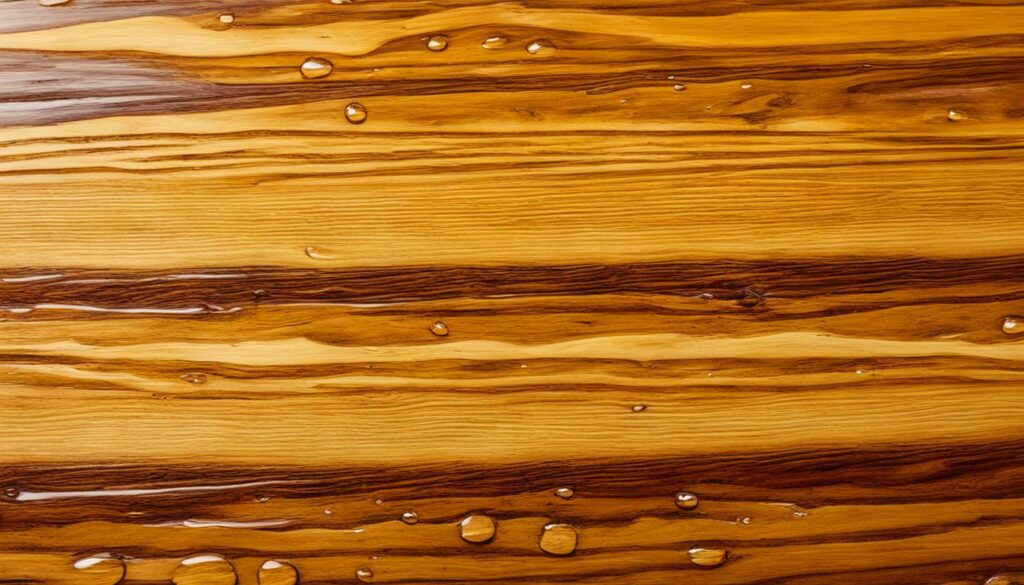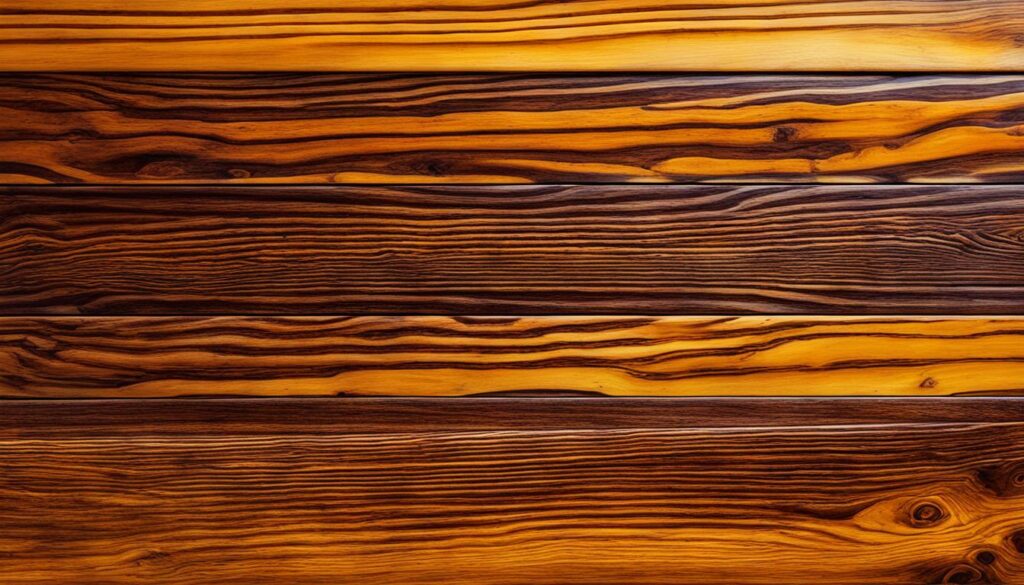Woodworkers often ask if they can add polyurethane over tung oil. The answer is yes. You can use polyurethane over tung oil. But, there are key things to remember for the best outcome.
Tung oil is a type of drying oil. It has an iodine number of 163-1731. This means it becomes hard and tough over time. But, how fast it dries depends on the kind. Pure tung oil takes more than 5 days to fully harden. Polymerized tung oil might just need a day1.
For a good finish, let the tung oil dry completely first. Then, lightly sand the surface and remove any dust. Doing these steps makes sure the polyurethane sticks well over the tung oil.
By sticking to these hints and steps, you can add polyurethane safely. This will make your woodwork look better and last longer. Next, we’ll cover more about tung oil and polyurethane. We’ll also talk about how to use them together in detail.
Understanding Tung Oil and Its Properties
Tung oil comes from the nuts of the tung tree. It’s been used in ancient China for thousands of years2. This oil is kind to the environment and safe for various surfaces. These include wood furniture, boat decks, and countertops2.
It soaks into wood and makes the grain stand out. This creates a finish that keeps out water and lasts a long time2. As the oil dries, it turns wood a beautiful oil. It’s not oily to the touch, though. It naturally protects the wood without being shiny2.
Different tung oils take different times to dry. Pure tung oil can take days. It’s not the best choice for wood finish. Boiled linseed oil works as well and costs less3. Tung oils that have been processed to dry quicker are also available2.
Before using tung oil, mix it with mineral spirits to help it soak in better. You might need multiple coats, but you usually don’t need to sand in between2. It dries faster than many other oils. Plus, you don’t need a topcoat of varnish over it2.
Tung oil is a versatile and eco-friendly finish that enhances the natural beauty of wood while providing durability and water resistance.
You might need to add more tung oil every six months to a year. FDA-approved food-grade tung oil is safe for items like cutting boards, too2.
| Finish | Drying Time | Durability | Water Resistance | Price |
|---|---|---|---|---|
| Pure Tung Oil | 5+ days | Good | Excellent | High |
| Boiled Linseed Oil | 24-48 hours | Good | Good | Low |
| Polymerized Tung Oil | 24 hours | Excellent | Excellent | Moderate |
Even though tung oil is more expensive, it’s harder and lasts longer than linseed oil2. If you plan to use polyurethane over tung oil, make sure to let it dry well first. Pure tung oil should have 5 days before you seal it with shellac. Polymerized tung oil needs 24 hours. But, you can use tung oil varnish right away3.
Polyurethane: A Popular Wood Finish
Polyurethane is a top choice for wood finishes. It creates a hard, protective layer that shields wood from harm. This includes scratches, moisture, and everyday wear4.

You can choose from different sheens, like satin or gloss, when picking a polyurethane finish4. Satin gives a subtle finish, while gloss is very shiny. Always apply thin coats and let them dry well. Follow the instructions on the product for the best results4.
Minwax and Arm-R-Seal are well-known brands for polyurethane. They are loved for being durable, easy to use, and for their quality. While using polyurethane, make sure you’re in a well-ventilated space. Also, protect yourself with gloves and a mask to avoid the fumes.
| Polyurethane Type | Characteristics | Drying Time |
|---|---|---|
| Oil-based | More durable, amber tint | Longer (24-48 hours) |
| Water-based | Less odor, clear finish | Shorter (2-4 hours) |
Follow these tips for the best polyurethane results:
- Make sure the wood is clean and free of dust.
- Sand the wood lightly between coats to keep it smooth4.
- Use a good brush to put on thin, even layers.
- Let each coat dry before adding the next. Don’t use steel wool in between, or it might cause problems3.
To wrap up, polyurethane is great for protecting and beautifying wood. Use it right, and your projects will look good for a long time.
Can You Put Polyurethane Over Tung Oil?
I love working with wood. I always wondered if polyurethane can go over tung oil. Tung oil makes wood look great, and polyurethane protects it. You can use poly over tung, but there are things you should know.
Let the tung oil dry well before adding polyurethane. How long this takes can change. Pure tung oil might need 5 days to dry3. But, polymerized tung oil might be ready in just 24 hours3. Some mixes can be used right away3.
After it’s dried, you need to prep the wood for poly. Gently sand it to make it smooth and clean up any dust. Sometimes, using a dewaxed shellac as a sealer helps the poly stick better.
Tung oil alone is good, but poly adds more protection. For busy places like tables, this can be really helpful. The “Can You Put Polyurethane Over Tung Oil?” chat had a lot of interest, with 7K views and 16 replies from 9 people5.
| Tung Oil Type | Recommended Drying Time |
|---|---|
| Pure Tung Oil | 5 days or more |
| Polymerized Tung Oil | 24 hours |
| Tung Oil Varnish Blend | No waiting required |
Choose the sheen of poly you like, like gloss or satin4. Let each coat dry well before the next. You’ll need to sand lightly and clean between coats for a smooth finish4.
Adding poly over tung oil is a smart move. It mixes looks with protection well. Just follow the right steps for drying, prepping, and applying. Your project will look great.
Steps to Apply Polyurethane Over Tung Oil
To get a strong and protective finish with polyurethane over tung oil, follow the right steps. It’s key to let things dry enough. The type of tung oil used affects how long you should wait. Pure tung oil needs up to 5 days. Polymerized tung oil only needs 24 hours3.

First, sand the area lightly. Use fine-grit sandpaper to make it smooth. Don’t use steel wool. It can make sticking and rusting issues3. After sanding, use a tack cloth to clean off dust. This makes the surface ready for polyurethane.
Use a wiping varnish or a mix for an even look. Products like Arm-R-Seal work well. For better drying, mix tung oil with polyurethane5. Put on thin coats of poly, one by one. Let each coat dry before adding more. Sand lightly between coats for a nicer finish.
| Number of Coats | Drying Time Between Coats | Total Drying Time |
|---|---|---|
| 2 coats | 4-6 hours | 8-12 hours |
| 3 coats | 4-6 hours | 12-18 hours |
Put on two or three layers of polyurethane for the best results. Some suggest putting dewaxed shellac sanding sealer first. This can help the poly stick better and work together5. Doing this adds to your finish’s durability.
If you’re using special woods like black walnut, try tung oil first. This can make the natural beauty stand out5. But, don’t use oil-based finishes on the insides of cedar boxes. They can mess up the drying process3.
Follow these steps properly. Let everything dry well. You’ll have a great finish. It will keep the wood looking natural but well-protected.
Alternatives to Applying Polyurethane Over Tung Oil
Applying polyurethane over tung oil is known for making a strong topcoat. Yet there are other finishes that are both stunning and durable. One choice is a mix of tung oil and polyurethane like Waterlox. This option dries quicker and offers a strong finish without multiple coats6. You can also make your own mix of polyurethane, tung oil, and turpentine. This mix can boost the wood’s natural look7. Tung oil shines for its natural look, water resistance, and being easy to use on many surfaces8.
Fancy a different look or worry about how the finish will match? You might like shellac or lacquer instead of polyurethane. Lacquer goes on easily, dries fast, and makes a tough finish. But, it might not handle heat and chemicals as well as polyurethane8. Dewaxed shellac can be a good sealer between tung oil and your finishing coat. It helps the final finish stick better and avoids issues6. Remember, with shellac, using dewaxed shellac is key for the finishing coat to stick right.
Looking for something really strong, especially for wet areas like kitchens and bathrooms? Epoxy or polyester finishes are recommended as very tough options7. Epoxy stands out as extremely durable, protecting against scratches and more8. For such areas, you might also consider oil-based enamel, latex paint, or clear coatings7. In the end, your choice of topcoat depends on what finish you want, how much protection you need, and what your project requires.
Source Links
- https://kingsfinewoodworking.com/blogs/news/can-i-apply-lacquer-or-polyurethane-over-an-oil-finish
- https://www.dutchcrafters.com/blog/things-to-know-about-tung-oil/
- https://sawmillcreek.org/showthread.php?143584-Apply-Poly-after-Tung-Oil
- https://www.hunker.com/13411941/how-to-refinish-with-polyurethane-over-tung-oil
- https://www.lumberjocks.com/threads/rookie-question-about-tung-oil-polyurethane.314065/
- https://sawmillcreek.org/showthread.php?42517-Mixing-tung-oil-with-poly
- https://woodweb.com/knowledge_base/Whats_a_Tough_Top_Coat_Over_Tung_Oil.html
- https://pinecarve.com/what-can-i-use-instead-of-polyurethane/
Welcome to WoodCraftYard.com, your one-stop destination for all things woodworking! I’m Oliver Candler, a dedicated woodworking aficionado and the creative mind behind this virtual woodworking haven. With a deep-rooted love for craftsmanship and a keen eye for detail, I am on a mission to share my passion for woodworking with fellow enthusiasts like yourself.
As a seasoned woodworker, I am committed to providing you with valuable insights, practical tips, and inspiring project ideas to help you unleash your creativity and master the art of woodworking. Whether you’re a seasoned pro or just starting out on your woodworking journey, join me as we carve, sand, and saw our way through the world of woodworking together.
Let’s embark on this woodworking adventure, where every knot, grain, and finish tells a unique story. Together, let’s craft, create, and build something truly extraordinary at WoodCraftYard.com!



